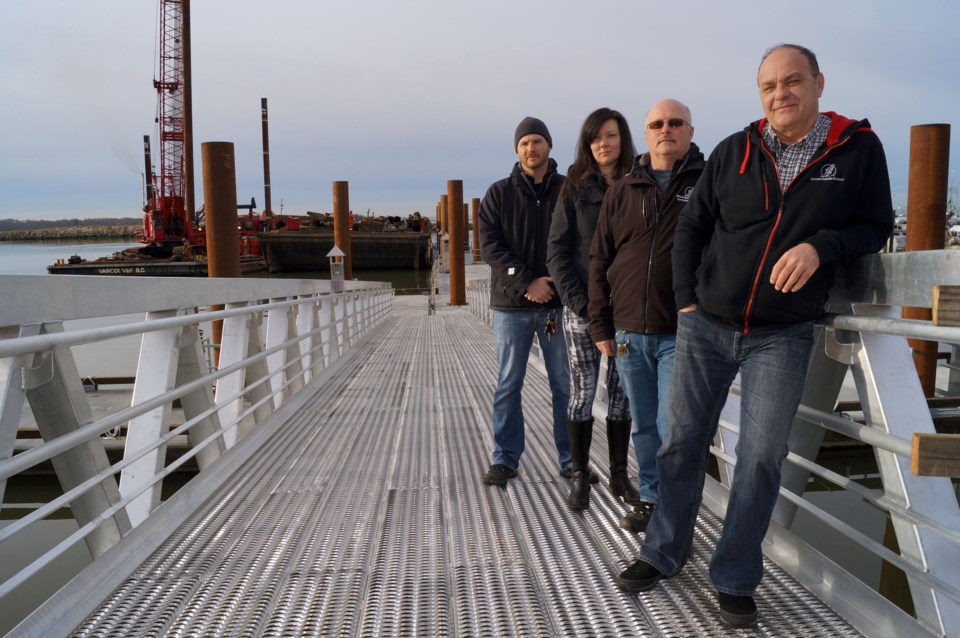A new, expanded public fish sales dock in Steveston is set to open within the next month, restoring a balance between the village’s historic, industrial roots and present-day forces of gentrification.
“Steveston was built on fishing and it’s been a fishing town for so many years; the (dock) is quite a focal point for the harbour; it’s industry interacting with the public; it’s an experience for locals and people from all over the Lower Mainland — all over the world actually. So, it’s a unique showpiece,” said Bob Baziuk, general manager of Steveston Harbour Authority (SHA).
The new concrete dock is a 25 per cent expansion of the old wooden one, which fell into disrepair since its 1989 opening.
There will actually be three interconnected docks, each spanning the length of a football field. The wheelchair-accessible docks have more safety features for fishers and the public, noted Baziuk.
“The previous public sales float was fully depreciated and this is a result of funds announced a couple of years ago to replace it, and that’s what you see today,” said Baziuk.
In May 2015, the federal government provided $14 million for harbour upgrades. Along with the new public fish sales dock, the harbour also replaced two other nearby docks, built a new fish auction wharf and dredged Steveston Channel.
The work was much needed, said Baziuk, as the harbour continues to be a home base for more than 500 commercial fishing vessels, making it the largest small craft harbour in Canada.
The daily operations are more easily hidden these days, behind the many new condos that have sprouted up over the past decade. With such growth has come more locals and others wanting to buy fresh fish.
The fish sales dock is considered a connector between the two worlds.
“This project is key. It allows us to help the fishers showcase their product to the public. It also allows people to come down and get a real view of the working harbour and allow people to communicate with the fishers, and see where the fish is coming from,” said Jamie Da Costa, SHA senior executive assistant.
“This was put in specifically for (fishers) to sell their catch to the public,” said Baziuk, who notes that fish sales are fully autonomous from SHA, and it’s a “buyer beware facility.”
The harbour, by way of its website (StevestonHarbour.com), does provide purchasing tips and regularly updates what products are being sold on the dock.
“We work to inform the public the best we can,” said Baziuk.
Nevertheless, fish prices — not to mention freshness — at the docks are rarely matched by supermarkets.
Operations supervisor Joel Baziuk noted that there is a diverse amount of fish being sold at the docks these days, despite a decline in salmon runs outside the Adams River run, every four years.
“The fishing industry isn’t dying, it’s changing; it always has, since First Nations were fishing here to when tall ships and the canning industry came. . . It’s the same thing today,” said Joel.
“Fishers are diversifying in order to stay in the business,” he said.
Notably, the Gulf of Georgia herring stocks are some of the healthiest in the world.
In many respects, the fish docks are a glimpse into the international fish trade.
Over the past few years, sea urchins, which could be caught as far north as Alaska, have become a hot commodity thanks, in large part, to Chinese buyers.
However, not every local catch is marketed on the dock, noted Joel.
For instance, hake is the largest fishery on B.C.’s coast, according to the David Suzuki Foundation, but Joel has yet to see it on the dock. That’s because it’s sold to Russia, and more recently, has been turned into fish meal, according to the foundation.
Last year, the industry dealt with a “bonanza” of chum salmon and Baziuk is gearing up for another big sockeye run next year.
For this, SHA is looking next to replace its old ice plant at the Paramount (east) docks.
“The one we currently have is old; I often refer to it as Grandma’s fridge; you know, you never know when it will break down, but it’s still working. Ice is the life blood of the commercial fishing industry. It’s essential to get that built,” said Baziuk.



